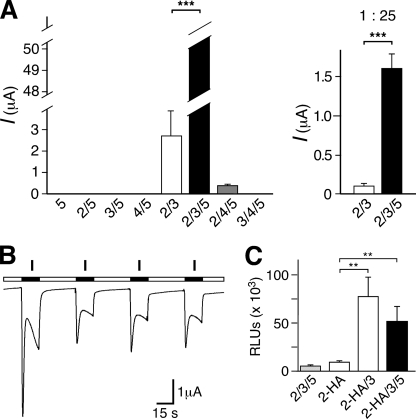FIGURE 4.
A, HyNaC5 potently increases the current amplitude of the HyNaC2/3 heteromer. Left, bar graphs illustrating the whole oocyte current amplitude after coexpression of different combinations of HyNaC subunits; HyNaCs were activated with 30 μm Hydra-RFamide I. For each condition, a total of ∼8 ng cRNA had been injected in oocytes. Note that the amplitude for HyNaC2/3/5 was >50 μA and therefore only a lower limit of the amplitude can be given. Error bars represent S.E.; for HyNaC2/3/5, the S.E. could not be calculated. n = 10 oocytes. Right, bar graphs illustrating current amplitude of oocytes coexpressing HyNaC2/3 or HyNaC2/3/5; a total of ∼0.3 ng cRNA had been injected. Both channels were activated with a concentration of Hydra-RFamide II eliciting half-maximal response: HyNaC2/3 with 33 μm and HyNaC2/3/5 with 0.35 μm. ***, p < 0.001. B, representative current traces for the HyNaC2/3/5 heteromer. Repeated activation of HyNaC2/3/5 with Hydra-RFamides led to decreased response between the first and second application; in the example shown, 30 μm Hydra-RFamide I was used. cRNA for HyNaCs 2, 3, and 5 was diluted 25-fold (a total of 0.3 ng/oocyte). C, HyNaC5 does not increase surface expression of the HyNaC2/3 heteromer. Surface expression of HyNaC2 and HyNaC2/3 in comparison to HyNaC2/3/5 (mean ± S.E.); only the HyNaC2 subunit was HA-tagged. Oocytes injected with untagged HyNaC2/3/5 served as a control (first column). The results are expressed as relative light units (RLUs)/oocyte/s (n = 16). **, p ≤ 0.01.

